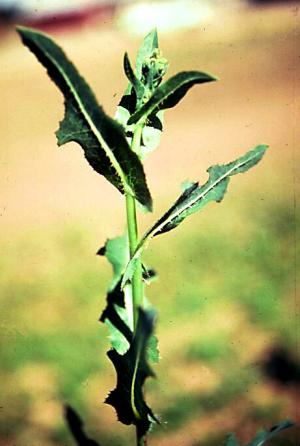CONTENTS
Registered Herbicides
[Return to weed
Identification]
[Return to Weed
Management]
[Home] |
|

General Description:
- Seedling leaves are slightly lobed with spines on
underside of midrib.
- Juvenile: Low, prostrate to bushy rosette.
Leaves 2 to 10 inches long with lobed entire margins. Blue green color, milky sap,
and spiny midrib underside are identifying traits.
- Mature: Grows upright 1-5 feet tall with
branches primarily in upper flowering portion of the plant. Leaves are alternate,
clasp the stem with angled lobes. Roots, stems, and leaves exude a milky juice when
broken. Taproot.
- Flower: Flowers pale to bright yellow.
Flower ray 1/8-1/3 inch in diameter (may dry to a blue color). Flowers borne on
slender stalks, terminally at branch ends.
Life cycle: Winter annual or biennial
- Reproduces only by seed.
- May overwinter as a rosette.
- Generally 1 stem arises from a rosette.
- Flowers July-September.
- May hybridize with cultivated lettuce.
Habitat/ Distribution:
- Native to Europe but now naturalized throughout the
U.S.
- A weed in orchards, ornatmental stock, horticultural
and agronomic crops, most irrigated crops, and roadsides.
- Thrives on nutrient rich soils.
Herbicide Control Notes:
- Gramoxone plus Goal effective. Stinger plus Buctril
effective in spring when followed by Sinbar. Gramoxone plus Karmex/Direx or Gramoxone plus
Sinbar effective in late fall.
|